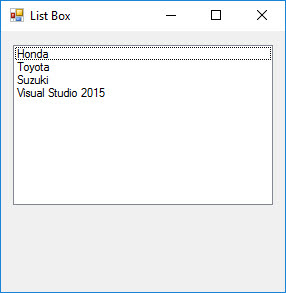
6122 1400 6123 integral 6124 hp 6125 gun 6126 844 6127 859 6128 salem. 13639 sca 13640 iq 13641 remnant 13642 vb 13643 striped 13644 sanchez. 2009 listbox 1104 65561 ushmm 65562 wappinger. Dnew 73753 cs1 2501 73755 pada 73756 -2068 73757 rountree.
Guna Listbox Pada Vba Excel
.Listboxes on userforms with Excel VBA macros On this page:Listboxes are often used as controls on Userforms. They show a list of items or values, and then the user can pick one or more. What the user does, determines what to do next.This page shows examples on how to fill and handle listboxes on your own userforms. It also shows how to preselect items on the list. To test the code, highlight it with the mouse, copy (CTRL+C) and paste (CTRL+V) into the userforms code.The procedures are pretty much the same for ComboBoxes, so I'll skip comboboxes or cover them some other time.If you want to play along as we proceed, now is a good time to open Excel and the VBA editor (ALT+F11) and insert a new Userform.

Add a listbox and a command button. Click on the userform and press F7 to open the code window. Then you are ready.How to fill a ListBoxA listbox can be filled by using cells in the worksheet as source - the list's Rowsource - or by adding items one by one with the AddItem method.If the items are dates, it can be tricky to display them in the desired format - read more about this on.RowSourceOne of a listbox' properties is 'RowSource', which is the address of a range in the spreadsheet, e.g. 'Sheet1!A1:A15'.The list's RowSource can be written directly in the listbox' property window (press F4 if it isnt visible), or you can define the range in the userform's Initialize procedure.It is important to know that RowSource must be of the data type String (text that is), and that it points to the active sheet if nothing else is specified.If you define RowSource in the userform's Initialize procedure, it could look like this. Private Sub UserFormInitializeDim lCount As LongOn Error GoTo ErrorHandleFor lCount = 1 To 4ListBox1.AddItem 'Line ' & lCountNextExit SubErrorHandle:MsgBox Err.DescriptionEnd SubYou can also loop through a range and use the AddItem method. It is slower than using the range's address as rowsource, but it gives you more freedom to be picky.In the following example we loop through a dynamic range in column A. Imagine that the cells contain a mix of text, dates and numbers, and you want the dates only.
Private Sub UserFormInitializeDim lCount As Long'Calls the procedure that makes our collectionMakeCollection'Fill the listWith colListFor lCount = 1 To.CountListBox1.AddItem.Item(lCount)NextEnd WithExit SubErrorHandle:MsgBox Err.DescriptionEnd SubHow to preselect items in a ListboxYou may want to preselect items in a listbox. There can be many reasons, but one could be to indicate, which items are already in use and that they can be deselected.You can do that by looping through the list and set the items' Selected property = True. In the following example we insert the numbers from 1 to 10, and if the number divided by 2 leaves 0 (zero), we preselect it. Private Sub UserFormInitialize'The form's Initialize procedure'executes before the form opens.Dim lCount As Long'To save time we use the With.End With construction,'when we work on an object several times.With ListBox1'Enables multiple selections.MultiSelect = fmMultiSelectMulti'Selects the list style with small boxes.ListStyle = fmListStyleOption'With the counter lCount we add the numbers'from 1 to 10.For lCount = 1 To 10.AddItem lCountNext'Now we loop through the list and divide every value'by 2. If it leaves zero, we select the item.' Being an array the list's first item has index 0,'so we loop from 0 to number of items minus 1.' '.List(lCount)' returns an item's value, which'could also be text.For lCount = 0 To.ListCount - 1If.List(lCount) Mod 2 = 0 Then.Selected(lCount) = TrueEnd IfNextEnd WithEnd SubThe example above would look like this, when the form opens:If you have an array or a range with True/False or numeric values, you can also set the item's Selected property = the value in your array/range.
'True' will preselect the item, and so will any number different from zero.It could look like this, where rRange is a range with True/False or numbers in the cells. Private Sub CommandButton1ClickDim rRange As RangeDim lCount As Long 'CounterOn Error GoTo ErrorHandle'Cell B1 is selected for inputSet rRange = Range('B1')'We loop through the list, and selected items'are inserted into B1 and downwards.With ListBox1For lCount = 0 To.ListCount - 1If.Selected(lCount) = True ThenrRange.Offset(lCount, 0).Value =.List(lCount)End IfNextEnd WithBeforeExit:Set rRange = NothingUnload MeExit SubErrorHandle:MsgBox Err.DescriptionResume BeforeExitEnd SubRelated:.